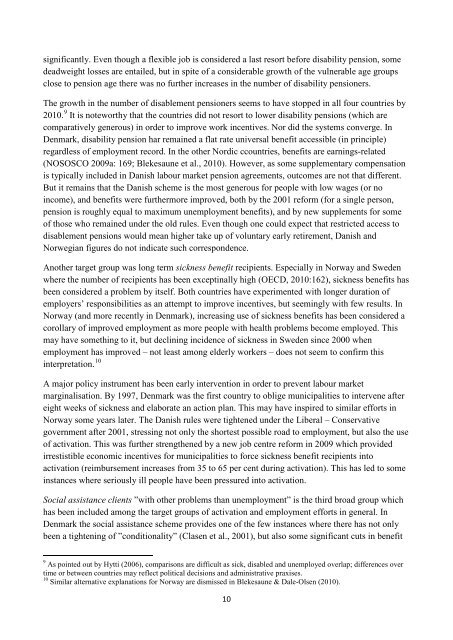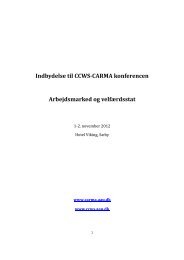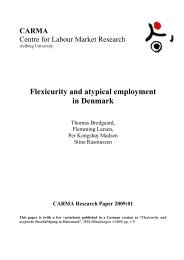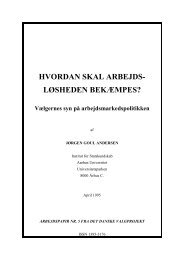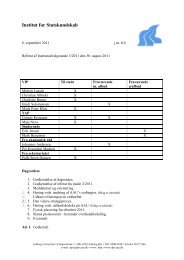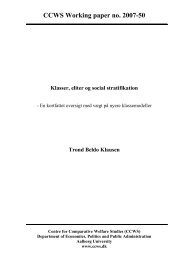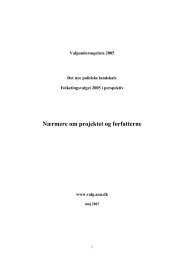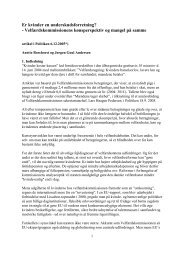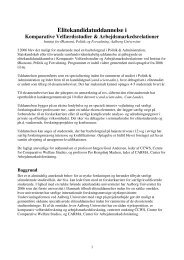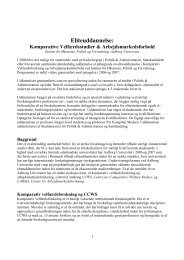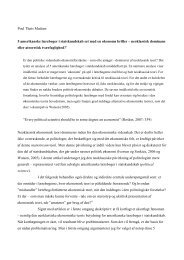significantly. Even though a flexible job is considered a last resort before disability pension, somedeadweight losses are entailed, but <strong>in</strong> spite of a considerable growth of <strong>the</strong> vulnerable age groupsclose to pension age <strong>the</strong>re was no fur<strong>the</strong>r <strong>in</strong>creases <strong>in</strong> <strong>the</strong> number of disability pensioners.The growth <strong>in</strong> <strong>the</strong> number of disablement pensioners seems to have stopped <strong>in</strong> all four countries by<strong>2010</strong>. 9 It is noteworthy that <strong>the</strong> countries did not resort to lower disability pensions (which arecomparatively generous) <strong>in</strong> order to improve work <strong>in</strong>centives. Nor did <strong>the</strong> systems converge. InDenmark, disability pension har rema<strong>in</strong>ed a flat rate universal benefit accessible (<strong>in</strong> pr<strong>in</strong>ciple)regardless of employment record. In <strong>the</strong> o<strong>the</strong>r <strong>Nordic</strong> ccountries, benefits are earn<strong>in</strong>gs-related(NOSOSCO 2009a: 169; Blekesaune et al., <strong>2010</strong>). However, as some supplementary compensationis typically <strong>in</strong>cluded <strong>in</strong> Danish labour market pension agreements, outcomes are not that different.But it rema<strong>in</strong>s that <strong>the</strong> Danish scheme is <strong>the</strong> most generous for people with low wages (or no<strong>in</strong>come), <strong>and</strong> benefits were fur<strong>the</strong>rmore improved, both by <strong>the</strong> 2001 <strong>reform</strong> (for a s<strong>in</strong>gle person,pension is roughly equal to maximum unemployment benefits), <strong>and</strong> by new supplements for someof those who rema<strong>in</strong>ed under <strong>the</strong> old rules. Even though one could expect that restricted access todisablement pensions would mean higher take up of voluntary early retirement, Danish <strong>and</strong>Norwegian figures do not <strong>in</strong>dicate such correspondence.Ano<strong>the</strong>r target group was long term sickness benefit recipients. Especially <strong>in</strong> Norway <strong>and</strong> Swedenwhere <strong>the</strong> number of recipients has been except<strong>in</strong>ally high (OECD, <strong>2010</strong>:162), sickness benefits hasbeen considered a problem by itself. Both countries have experimented with longer duration ofemployers’ responsibilities as an attempt to improve <strong>in</strong>centives, but seem<strong>in</strong>gly with few results. InNorway (<strong>and</strong> more recently <strong>in</strong> Denmark), <strong>in</strong>creas<strong>in</strong>g use of sickness benefits has been considered acorollary of improved employment as more people with health problems become employed. Thismay have someth<strong>in</strong>g to it, but decl<strong>in</strong><strong>in</strong>g <strong>in</strong>cidence of sickness <strong>in</strong> Sweden s<strong>in</strong>ce 2000 whenemployment has improved – not least among elderly workers – does not seem to confirm this<strong>in</strong>terpretation. 10A major policy <strong>in</strong>strument has been early <strong>in</strong>tervention <strong>in</strong> order to prevent labour marketmarg<strong>in</strong>alisation. By 1997, Denmark was <strong>the</strong> first country to oblige municipalities to <strong>in</strong>tervene aftereight weeks of sickness <strong>and</strong> elaborate an action plan. This may have <strong>in</strong>spired to similar efforts <strong>in</strong>Norway some years later. The Danish rules were tightened under <strong>the</strong> Liberal – Conservativegovernment after 2001, stress<strong>in</strong>g not only <strong>the</strong> shortest possible road to employment, but also <strong>the</strong> useof activation. This was fur<strong>the</strong>r streng<strong>the</strong>ned by a new job centre <strong>reform</strong> <strong>in</strong> 2009 which providedirrestistible economic <strong>in</strong>centives for municipalities to force sickness benefit recipients <strong>in</strong>toactivation (reimbursement <strong>in</strong>creases from 35 to 65 per cent dur<strong>in</strong>g activation). This has led to some<strong>in</strong>stances where seriously ill people have been pressured <strong>in</strong>to activation.Social assistance clients ”with o<strong>the</strong>r problems than unemployment” is <strong>the</strong> third broad group whichhas been <strong>in</strong>cluded among <strong>the</strong> target groups of activation <strong>and</strong> employment efforts <strong>in</strong> general. InDenmark <strong>the</strong> social assistance scheme provides one of <strong>the</strong> few <strong>in</strong>stances where <strong>the</strong>re has not onlybeen a tighten<strong>in</strong>g of ”conditionality” (Clasen et al., 2001), but also some significant cuts <strong>in</strong> benefit9 As po<strong>in</strong>ted out by Hytti (2006), comparisons are difficult as sick, disabled <strong>and</strong> unemployed overlap; differences overtime or between countries may reflect political decisions <strong>and</strong> adm<strong>in</strong>istrative praxises.10 Similar alternative explanations for Norway are dismissed <strong>in</strong> Blekesaune & Dale-Olsen (<strong>2010</strong>).10
levels. The latter measures were adopted with <strong>the</strong> support of <strong>the</strong> ”<strong>welfare</strong> chauv<strong>in</strong>ist” <strong>and</strong> antiimmigrationDanish People’s Party, <strong>and</strong> <strong>the</strong>y were explicitly targeted at non-western immigrants(Goul Andersen, 2007b) but were announced to be ab<strong>and</strong>oned by <strong>the</strong> <strong>in</strong>com<strong>in</strong>g Social Democraticled government <strong>in</strong> 2011. S<strong>in</strong>ce 2002, <strong>the</strong> <strong>reform</strong>s – dubbed poverty measures by <strong>the</strong> SocialDemocrats – has <strong>in</strong>cluded a substantially lower social assistance 11 for immigrants arriv<strong>in</strong>g fromnon-EU countries (labelled ”start assistance” or ”<strong>in</strong>troductory benefits”). It has <strong>in</strong>cluded cuts <strong>in</strong>social assistance for some family types <strong>in</strong> order to ”make work pay” <strong>in</strong> any <strong>in</strong>stance (this wasactually a part of a broad political compromise <strong>in</strong>clud<strong>in</strong>g <strong>the</strong> Social Democrats <strong>in</strong> 2002). And it<strong>in</strong>cluded an ”<strong>in</strong>tegration package” <strong>in</strong> 2005 with a requirement that married people <strong>in</strong> worklesshouseholds should have ord<strong>in</strong>ary employment for at least 300 hours over a two-year period <strong>in</strong> orderto ma<strong>in</strong>ta<strong>in</strong> <strong>the</strong> right to social assistance (Christensen, 2007). 12 By 2008, this was <strong>in</strong>creased to 450hours <strong>and</strong> extended to all married social assistance recipients. 13 The work requirement applied tofour out of five ”match<strong>in</strong>g groups”, except<strong>in</strong>g <strong>the</strong> fifth match<strong>in</strong>g group (some 20 per cent)considered completely unemployable. 14 By <strong>2010</strong> <strong>the</strong> match<strong>in</strong>g groups were rationalized to onlythree categories. All <strong>the</strong> measures mentioned above, however, were announced <strong>in</strong> 2011 to beab<strong>and</strong>oned.At any rate, <strong>the</strong>se policies towards immigrants were <strong>the</strong> exception. Generally speak<strong>in</strong>g, immigrantsare well <strong>in</strong>cluded <strong>in</strong> <strong>the</strong> universal <strong>welfare</strong> state (Goul Andersen, 2007). However, <strong>the</strong> ”active l<strong>in</strong>e”or ”work l<strong>in</strong>e” of labour market policies <strong>in</strong> <strong>the</strong> <strong>Nordic</strong> countries have targeted immigrants to alarger degree than previously, <strong>and</strong> new policies have been developed to ensure <strong>in</strong>tegration <strong>and</strong>enhance labour market chances (Djuve, 2011). These efforts were stimulated e.g. by OECDstatistics reveal<strong>in</strong>g that <strong>the</strong> <strong>Nordic</strong> countries exhibited unusually large employment <strong>and</strong>unemployment gaps between immigrants <strong>and</strong> natives, as compared to o<strong>the</strong>r European countries(Mogensen & Matthiesen, 2000, 2002; Coleman & Wadensjö, 1999; Brochmann & Hagelund,<strong>2010</strong>: 314, 362-63). 15Partly as a response, all four countries developed relatively comprehensive <strong>in</strong>troductionprogrammes for immigrants – m<strong>and</strong>atory <strong>in</strong> Denmark, Norway <strong>and</strong> F<strong>in</strong>l<strong>and</strong>, voluntary <strong>and</strong>decentralized <strong>in</strong> Sweden (Djuve & Kavli, 2007: 39-56; Breidahl, 2008; Brochmann & Hagelund,<strong>2010</strong>: 342-350; Sarvimäki & Hämälä<strong>in</strong>en, <strong>2010</strong>). These programmes <strong>in</strong>clude not least languagecourses, <strong>and</strong> general <strong>in</strong>formation about <strong>the</strong> society. The Swedish programmes were developed from1991, Denmark <strong>and</strong> F<strong>in</strong>l<strong>and</strong> followed <strong>in</strong> 1999, <strong>and</strong> Norway <strong>in</strong> 2004. Empirical tests <strong>in</strong> F<strong>in</strong>l<strong>and</strong>(exploit<strong>in</strong>g <strong>the</strong> ”natural experiment” situation) <strong>in</strong>dicates that <strong>the</strong> impact of <strong>the</strong> <strong>in</strong>troductionprogramme as such on labour market performance is considerable (Sarvimäki & Hämälä<strong>in</strong>en,11 In Denmark social assistance rema<strong>in</strong> means-tested, but entitlements were pegged to maximum unemployment<strong>in</strong>surance <strong>in</strong> <strong>the</strong> 1980s. By <strong>the</strong> mid-<strong>1990</strong>s it was fixed at 60 per cent for a s<strong>in</strong>gle person.12 Even though <strong>the</strong> <strong>reform</strong> carried <strong>the</strong> label ”<strong>in</strong>tegration package”, <strong>the</strong> rules applied to all citizens regardless ofeth<strong>in</strong>icity or citizenship. Like <strong>in</strong> 2002, however, <strong>the</strong>re were explicit calculations <strong>in</strong>dicat<strong>in</strong>g to what extent <strong>the</strong> rules defacto targeted non-western immigrants (Goul Andersen, 2007).13 This was a compsation to <strong>the</strong> Danish People’s Party follow<strong>in</strong>g <strong>the</strong> so-called ”Metock verdict” of <strong>the</strong> European Courtof Justice which could facilitate immigration.14 The Social Democrats had orig<strong>in</strong>ally agreed <strong>in</strong> a political compromise, but chose <strong>the</strong> opportunity to exit when it wasoperationalized <strong>in</strong>to a more far-reach<strong>in</strong>g law than envisaged.15 In political discourse, this has often been <strong>in</strong>terpreted as <strong>in</strong>dicator of dis<strong>in</strong>centives of <strong>the</strong> <strong>welfare</strong> state; however, <strong>the</strong>strong emphasis on humanitarian <strong>in</strong>tegration <strong>and</strong>, correspond<strong>in</strong>gly, <strong>the</strong> heavy weight of refugees among immigrants, is<strong>the</strong> ma<strong>in</strong> explanation of <strong>the</strong> difference (Christensen, 2009).11


